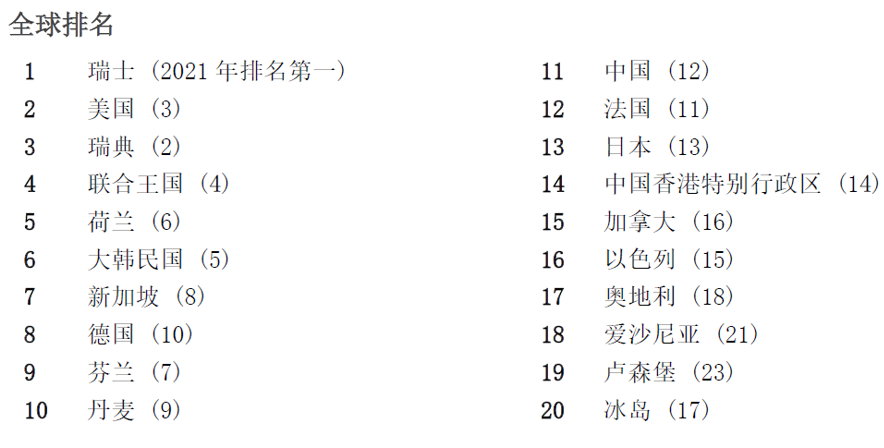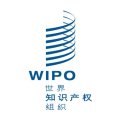
WIPO China: China Approaches Top 10 in GII 2022,Impact-Driven Innovation Needed in Turbulent Times

图:WIPO | Photo: WIPO
根据产权组织2022年全球创新指数(GII),瑞士、美国、瑞典、联合王国和荷兰是世界上最具创新性的经济体,而中国离前十仅有一步之遥。其他新兴经济体也保持了一贯的强劲表现,包括印度和土耳其,这两个国家首次进入前40名。
Switzerland, the United States, Sweden, the United Kingdom and the Netherlands are the world’s most-innovative economies, according to WIPO’s 2022 Global Innovation Index (GII), with China on the threshold of the top 10. Other emerging economies are also showing consistently strong performance, including India and Türkiye, both of which enter the top 40 for the first time.
报告显示,尽管发生了COVID-19疫情,但推动全球创新活动的研发和其他投资在2021年继续蓬勃发展,不过,在将创新投资转化为影响力方面却出现了种种挑战。
The report shows that research and development (R&D) and other investments that drive worldwide innovative activity continued to boom in 2021 despite the COVID-19 pandemic, but challenges are emerging in translating innovation investments into impact.
GII发现,生产力增长——通常受更多的创新所刺激——事实上已经停滞。GII还发现,尽管研发支出和风险资本投资在近期方兴未艾,但目前的技术进步和采用都有放缓的迹象。不过,如果对创新生态系统加以精心扶持,一个由数字时代和深层科学创新浪潮引领的创新驱动增长的新时代也许会腾飞。
The GII finds that productivity growth – normally spurred by increased innovation – has in fact stagnated. It also finds that current technological progress and adoption show signs of slowing growth despite the recent flourishing of R&D expenditure and venture capital investments. However, with more careful and attentive nurturing of innovation ecosystems, a new era of innovation-driven growth led by Digital Age and Deep Science innovation waves could take off.
“今年的GII发现,随着我们走出大流行病,创新正处于一个十字路口。虽然创新投资在2020年和2021年出现激增,但全球的不确定性,还有创新驱动生产力方面持续的下滑表现,给2022年的前景投下了阴霾。这就是为什么我们不仅要更加关注对创新的投资,还要关注如何将投资转化为经济和社会影响力。质量和价值对成功的重要性不亚于数量和规模。”
“This year’s GII finds that innovation is at a crossroads as we emerge from the pandemic. While innovation investments surged in 2020 and 2021, the outlook for 2022 is clouded not just by global uncertainties but continued underperformance in innovation-driven productivity. This is why we need to pay more attention to not just investing in innovation, but how it translates into economic and social impact. Quality and value will become as critical to success as quantity and scale.”
产权组织总干事邓鸿森
WIPO Director General Daren Tang
GII的主要发现包括:
Among the GII’s key findings:
1
2021年,全球顶级企业的研发支出增加近10%,达9,000多亿美元,高于大流行病发生前的2019年。这一增长主要由四个行业推动:ICT硬件和电气设备;软件和ICT服务;制药和生物技术;以及建筑和工业金属。
The top global corporate R&D spenders increased their R&D expenditure by almost 10 percent to over USD 900 billion in 2021, higher than in 2019 before the pandemic. This increase was primarily driven by four industries: ICT hardware and electrical equipment; Software and ICT services; pharmaceuticals and biotechnology; and construction and industrial metals.
2
2020年全球研发投资增长率为3.3%,但比2019年创记录的6.1%的历史高点有所放缓。2020年,研发支出最高的经济体的政府预算拨款显示出强劲的增长。2021年的政府研发预算却是另一番景象:大韩民国和德国的支出在增加,美国和日本则在减少。
Investments in global R&D in 2020 grew at a rate of 3.3 percent, but slowed from the historically high 6.1 percent R&D growth rate recorded in 2019. Government budget allocations for the top R&D spending economies showed strong growth in 2020. For 2021 government R&D budgets, the picture was more varied, with spending growing in the Republic of Korea and Germany, but falling in the US and Japan.
3
2021年,风险投资交易激增46%,与20世纪90年代末互联网繁荣时期的创纪录水平不相上下。拉丁美洲和加勒比地区以及非洲地区的风险投资增长最为强劲。不过,2022年的风险投资前景更加清醒;紧缩的货币政策和对风险投资的影响将导致风险投资减速。
Venture capital (VC) deals exploded by 46 percent in 2021, recording levels comparable to the internet boom years of the late 1990s. Latin America and the Caribbean and Africa regions witnessing the strongest VC growth. The VC outlook for 2022 is more sober however; tightening monetary policies and the effect on risk capital will lead to a deceleration in VC.
在世界经济体创新能力及产出年度排名中,GII显示出前15位排名的一些关键变化,美国攀升至第二,荷兰取得第五,新加坡第七,德国第八,中国上升一位至第11名,离前十仅一步之遥。
In its annual ranking of the world’s economies on innovation capacity and output, the GII shows some key changes in the top 15 of the ranking, with the United States climbing to the 2nd position, the Netherlands reaching the 5th position, Singapore reaching 7th, Germany reaching 8th and China up one place to 11th and on the doorstep of the top 10.
加拿大重新跻身全球创新者前15名(第15位)。土耳其(第37位)和印度(第40位)首次进入前40名。除此之外,越南(第48位)、伊朗伊斯兰共和国(第53位)和菲律宾(第59位)是迄今为止在创新表现方面进步最快的中等收入经济体。
Canada is back among the top 15 global innovators (15th). Türkiye (37th) and India (40th) enter the top 40 for the first time. Beyond these, Viet Nam (48), the Islamic Republic of Iran (53rd) and the Philippines (59th) are the middle-income economies with the fastest innovation performance growth to-date.

图:WIPO | Photo: WIPO
就经济发展水平而言,一些发展中经济体在创新方面的表现高于预期,这包括新加入的印度尼西亚、乌兹别克斯坦和巴基斯坦。八个创新表现优异的国家来自撒哈拉以南非洲,其中肯尼亚、卢旺达和莫桑比克处于领先地位。在拉丁美洲和加勒比地区,巴西、秘鲁和牙买加的表现超出了发展水平。
Several developing economies are performing above expectation on innovation relative to their level of economic development, including newcomers Indonesia, Uzbekistan and Pakistan. Eight innovation over performers are from Sub-Saharan Africa, with Kenya, Rwanda and Mozambique in the lead. In Latin America and the Caribbean, Brazil, Peru and Jamaica are outperforming relative to development.
“在全球供应链的冲击下,土耳其和印度在创新表现方面的进步积极地充实了全球创新图景,而印度尼西亚则显示出令人期待的创新潜力,”GII联合编辑、牛津大学赛德商学院院长苏米特拉·杜塔说。“其他地区的佼佼者,如拉丁美洲的智利和巴西,撒哈拉以南非洲的南非和博茨瓦纳,在相对创新表现方面都有进步。”
“With their rise in terms of innovation performance in the shadow of shocks to global supply chains, Türkiye and India are positively enriching the global innovation landscape, while Indonesia shows promising innovation potential, ” says GII Co-editor and Dean of the Saïd Business School at Oxford University, Soumitra Dutta. “Other regional champions like Chile and Brazil in Latin America, and South Africa and Botwana in Sub-Saharan Africa, have improved their relative innovation performance.”
2022年GII的主题重点:创新驱动增长的前景如何?
GII 2022 thematic focus asks: What is the future of innovation-driven growth?
2022年GII勾勒出两波可能的创新浪潮:
(i)建立在超级计算、人工智能和自动化基础上的数字时代创新浪潮,它即将对所有部门和科研领域的生产力产生充分的影响;
(ii)建立在生物技术、纳米技术、新材料和其他科学突破基础上的深层科学创新浪潮,它正在彻底改变对社会至关重要的四个领域的创新:健康、食品、环境和交通出行。
The GII 2022 sketches out the possibility of two novel innovation waves:
(i) a Digital Age innovation wave built on supercomputing, artificial intelligence and automation, which is on the verge of making ample productivity impacts across all sectors and fields of scientific research, and
(ii) a Deep Science innovation wave built on breakthroughs in biotechnologies, nanotechnologies, new materials and other sciences, which is revolutionizing innovations in four fields of key importance to society: Health, Food, Environment and Mobility.
然而,2022年GII警告说,这两波新浪潮的积极影响将需要很久才能变现;必须首先克服许多障碍,特别是在技术采用和技术传播领域。
However, the GII 2022 warns that the positive effects of these two novel waves will take time to materialize; many obstacles, particularly in the area of technology adoption and diffusion, have to be overcome first.
“生产力处于我们所向往的未来社会和经济的核心,尤其是如果我们想在更合理地利用自然资源的同时,又实现更高水平的平等的话。今天,在数字时代和深层科学浪潮的引导下,一场真正的革命正在推动创新。我们担负的共同责任是,从近期的危机中吸取教训,使这场革命走上正轨,并朝着我们向往的未来前进。”
“Productivity is at the core of what we want our societies and economies to be tomorrow, in particular if we want to combine higher levels of equality while using natural resources more sensibly. A true revolution is driving innovation today, guided by Digital Age and Deep Science waves. We have a collective responsibility to draw the lessons of recent crises to put this revolution on the right track, and gear it to the future we want.”
GII联合编辑和Portulans研究所联合创始人布吕诺•朗万
GII Co-Editor and Portulans Institute Co-Founder Bruno Lanvin
关于全球创新指数
About the Global Innovation Index
2022年全球创新指数(GII)今年是第十五版,由产权组织与Portulans研究所合作出版,并得到以下企业网络合作伙伴的支持:印度工业联合会(CII)、巴西全国工业联盟(CNI)、Ecopetrol(哥伦比亚)和土耳其出口商大会(TİM)。2021年建立了学术网络PDF,使世界一流高校参与GII研究,并向学术界传播GII数据和研究结果。
The Global Innovation Index 2022 (GII), in its 15th edition this year, is published by WIPO, in partnership with the Portulans Institute and with the support of our Corporate Network partners: the Confederation of Indian Industry (CII), the Brazilian National Confederation of Industry (CNI), Ecopetrol (Colombia), and the Turkish Exporters Assembly (TİM). In 2021, an Academic Network was established PDF to engage world-leading universities in GII research and to disseminate GII data and findings to the academic community.
自2007年首次推出以来,GII已打造出衡量创新的议程,并成为了经济决策的基石,越来越多的政府对其年度GII结果展开系统性分析,并制定政策应对措施以改善其表现。联合国经济及社会理事会在其2019年关于科学、技术和创新促进发展的决议中也承认GII是衡量与可持续发展目标有关的创新的权威基准。
Since its inception in 2007, the GII has shaped the innovation measurement agenda and become a cornerstone of economic policymaking, with an increasing number of governments systematically analyzing their annual GII results and designing policy responses to improve their performance. The GII has also been recognized by the UN Economic and Social Council in its 2019 resolution on Science, Technology and Innovation for Development as an authoritative benchmark for measuring innovation in relation to the Sustainable Development Goals (SDGs).
GII每年发布,其核心是提供衡量表现的指标并对132个经济体的创新生态系统进行排名。该指数以丰富的数据集为基础——来自国际公私部门的81个指标集合——超越了传统的创新措施,因为创新的定义已经拓宽。GII不再局限于研发实验室以及发表的科学论文,而在本质上更具普遍性和横向性,包括社会、商业模式和技术层面。
Published annually, the core of the GII provides performance measures and ranks 132 economies on their innovation ecosystems. The Index is built on a rich dataset – the collection of 81 indicators from international public and private sources – going beyond the traditional measures of innovation since the definition of innovation has broadened. It is no longer restricted to R&D laboratories and published scientific papers, and rather, is more general and horizontal in nature, including social, business model and technical aspects.
针对每个经济体都有一页情况介绍,其中记录了该经济体相对于指数中所有其他经济体而言,在所有指标上的表现。经济体情况介绍还强调了该经济体的相对创新优势和劣势。
For each economy a one-page profile is produced in which that economy’s performance on all indicators is recorded, relative to all other economies in the Index. The economy profiles also highlight an economy’s relative innovation strengths and weaknesses.
2022年GII是以两个次级指数的平均值计算的。创新投入次级指数衡量的是支持和促进创新活动的经济要素,这些要素共分为五大类:(1)制度,(2)人力资本与研究,(3)基础设施,(4)市场成熟度和(5)商业成熟度。创新产出次级指数体现的是经济中创新活动的实际成果,分为两大类:(6)知识与技术产出和(7)创意产出。
The GII 2022 is calculated as the average of two sub-indices. The Innovation Input Sub-Index gauges elements of the economy that enable and facilitate innovative activities and is grouped in five pillars: (1) Institutions, (2) Human capital and research, (3) Infrastructure, (4) Market sophistication, and (5) Business sophistication. The Innovation Output Sub-Index captures the actual result of innovative activities within the economy and is divided in two pillars: (6) Knowledge and technology outputs and (7) Creative outputs.
该指数提交给欧盟委员会联合研究中心进行独立的统计数据审计。下载报告全文请访问:www.globalinnovationindex.org。
The index is submitted to an independent statistical audit by the Competence Centre on Composite Indicators and Scoreboards (COIN) from the European Commission’s Joint Research Centre. To download the full report visit: www.globalinnovationindex.org.
点击阅读原文查看关于GII 2022更多信息。

本篇文章来源于微信公众号: WIPO中国 ,如有侵权请即使联系进行删除









